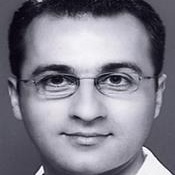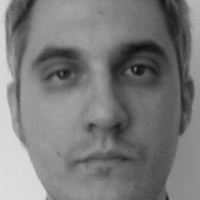International Journal of Image, Graphics and Signal Processing (IJIGSP)
IJIGSP Vol. 6, No. 7, 8 Jun. 2014
Cover page and Table of Contents: PDF (size: 1115KB)
Applied Computational Engineering in Magnetic Resonance Imaging: A Tumor Case Study
Full Text (PDF, 1115KB), PP.1-9
Views: 0 Downloads: 0
Author(s)
Index Terms
Applied Computational Engineering, Classic-Curvature, Intensity-Curvature term, Intensity-Curvature Functional, Polynomial Function, Re-sampling, Signal Resilient to Interpolation
Abstract
This paper solves the biomedical engineering problem of the extraction of complementary and/or additional information related to the depths of the anatomical structures of the human brain tumor imaged with Magnetic Resonance Imaging (MRI). The combined calculation of the signal resilient to interpolation and the Intensity-Curvature Functional provides with the complementary and/or additional information. The steps to undertake for the calculation of the signal resilient to interpolation are: (i) fitting a polynomial function to the signal, (ii) the calculation of the classic-curvature of the signal, (iii) the calculation of the Intensity-Curvature term before interpolation of the signal, (iv) the calculation of the Intensity-Curvature term after interpolation of the signal, (v) the solution of the equation of the two aforementioned Intensity-Curvature terms of the signal provides with the signal resilient to interpolation. The Intensity-Curvature Functional is the result of the ratio between the two Intensity-Curvature terms before and after interpolation. Because of the fact that the signal resilient to interpolation and the Intensity-Curvature Functional are derived through the process of re-sampling the original signal, it is possible to obtain an immense number of images from the original MRI signal. This paper shows the combined use of the signal resilient to interpolation and the Intensity-Curvature Functional in diagnostic settings when evaluating a tumor imaged with MRI. Additionally, the Intensity-Curvature Functional can identify the tumor contour line.
Cite This Paper
Carlo Ciulla, Dijana Capeska Bogatinoska, Filip A. Risteski, Dimitar Veljanovski,"Applied Computational Engineering in Magnetic Resonance Imaging: A Tumor Case Study", IJIGSP, vol.6, no.7, pp.1-9, 2014. DOI: 10.5815/ijigsp.2014.07.01
Reference
[1]C. Ciulla, "Signal resilient to interpolation: An exploration on the approximation properties of the mathematical functions", CreateSpace Publisher, U.S.A., 2012.
[2]C. Ciulla, "Improved signal and image interpolation in biomedical applications: The case of magnetic resonance imaging (MRI)", Medical Information Science Reference - IGI Global Publisher, Hershey, PA, U.S.A., 2009.
[3]S. Ouadfel, and S. Meshoul, "A Fully adaptive and hybrid method for image segmentation using multilevel thresholding", International Journal of Image, Graphics and Signal Processing, vol. 5, no. 1, pp. 46-57, 2013.
[4]N. Sumitra, and R. K. Saxena, "Brain tumor classification using back propagation neural network", International Journal of Image, Graphics and Signal Processing, vol. 5, no. 2, pp. 45-50, 2013.
[5]M. A. Amirkhizi, and S. Haghipour, "Left ventricle segmentation in magnetic resonance images with modified active contour method", International Journal of Image, Graphics and Signal Processing, vol. 5, no. 10, pp. 19-25, 2013.
[6]V. Pathak, P. Dhyani, and P. Mahanti, "Autonomous image segmentation using density-adaptive dendritic cell algorithm", International Journal of Image, Graphics and Signal Processing, vol. 5, no. 10, pp. 26-35, 2013.
[7]A. B. Al-Othman, Z. Al-Ameen, and G. B. Sulong, "Improving the MRI tumor segmentation process using appropriate image processing techniques", International Journal of Image, Graphics and Signal Processing, vol. 6, no. 2, pp. 23-29, 2014.
[8]K.M. Iftekharuddin, J. Zheng, M.A. Islam, and R.J. Ogg, "Fractal-based brain tumor detection in multimodal MRI", Applied Mathematics and Computation, vol. 207, no. 1, 23-41, 2009.
[9]A. Islam, S.M.S. Reza, and K.M. Iftekharuddin, "Multifractal texture estimation for detection and segmentation of brain tumors", IEEE Transactions on Biomedical Engineering, vol. 60, no. 11, 3204 - 3215, 2013.
[10]Y. Zhu, and H. Yan, "Computerized tumor boundary detection using a Hopfield neural network", IEEE Transactions on Medical Imaging, vol. 16, no. 1, 55-67, 1997.
[11]M. Prastawa, E. Bullitt, N. Moon, K. Van Leemput, and G. Gerig, "Automatic brain tumor segmentation by subject specific modification of atlas priors", Academic Radiology, vol. 10, no. 12, 1341-1348, 2003.
[12]M.C. Clark, L.O. Hall, D.B. Goldgof, R. Velthuizen, F.R. Murtagh, and M.S. Silbiger, "Automatic tumor segmentation using knowledge-based techniques", IEEE Transactions on Medical Imaging. vol. 17, no. 2, pp. 187–201, 1998.
[13]R. B. Dubey, M. Hanmandlu, S. K. Gupta, and S.K. Gupta, "Semi-automatic segmentation of MRI Brain tumor", ICGST-GVIP Journal, vol. 9, no. 4, pp. 33-40, 2009.
[14]D. T. Gering, W. E. L. Grimson, and R. Kikinis, Recognizing deviations from normalcy for brain tumor segmentation, Springer Berlin Heidelberg, pp. 388-395, 2002.
[15]A. Hamamci, G. Unal, N. Kucuk, and K. Engin, "Cellular automata segmentation of brain tumors on post contrast MR images", In: Medical Image Computing and Computer-Assisted Intervention – MICCAI, Springer Berlin Heidelberg, pp. 137-146, 2010.
[16]A. Hamamci, N. Kucuk, K. Karaman, K. Engin, G. Unal, "Tumor-cut: segmentation of brain tumors on contrast enhanced MR images for radiosurgery applications", IEEE Transactions on Medical Imaging, vol. 31, no. 3, pp. 790-804, 2012.
[17]M. M. Letteboer, O. F. Olsen, E. B. Dam, P. W. Willems, M. A. Viergever, and W. J. Niessen, "Segmentation of tumors in magnetic resonance brain images using an interactive multiscale watershed algorithm", Academic Radiology, vol. 11, no. 10, pp. 1125-1138, 2004.
[18]S. Ruan, B. Moretti, J. Fadili, and D. Bloyet, "Fuzzy Markovian segmentation in application of magnetic resonance images", Computer Vision and Image Understanding, vol. 85, no. 1, pp. 54-69, 2002.
[19]S. Shen, W. Sandham, M. Granat, and A. Sterr, "MRI fuzzy segmentation of brain tissue using neighborhood attraction with neural-network optimization", IEEE Transactions on Information Technology in Biomedicine, vol. 9, no. 3, pp. 459-467, 2005.
[20]Y. Zhang, M. Brady, and S. Smith, "Segmentation of brain MR images through a hidden Markov random field model and the expectation-maximization algorithm", IEEE Transactions on Medical Imaging, vol. 20, no. 1, pp. 45-57, 2001.
[21]C. De Boor, "A practical guide to splines" Applied mathematical sciences, Springer-Verlag, 1978.
[22]M. Unser, A. Aldroubi, and M. Eden, "B-spline signal processing: Part I – theory", IEEE Transactions on Signal Processing, vol. 41, no. 2, pp. 821-833, 1993a.
[23]M., Unser, A. Aldroubi, and M. Eden, "B-spline signal processing: Part II – efficient design and applications", IEEE Transactions on Signal Processing, vol. 41, no. 2, pp. 834-848, 1993b.
[24]C. Ciulla, "The intensity-curvature functional of the trivariate cubic Lagrange interpolation formula", International Journal of Image, Graphics and Signal Processing, vol. 5, no. 10, pp. 36-44, 2013.
[25]C. Ciulla, "On the signal-image intensity-curvature Content", International Journal of Image, Graphics and Signal Processing, vol. 5, no. 5, pp. 15-21, 2013.



